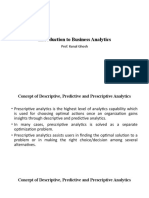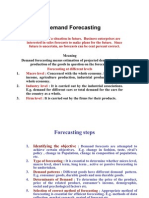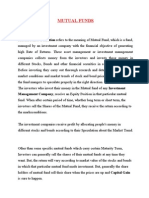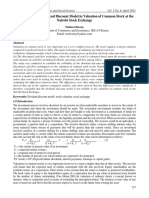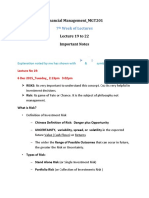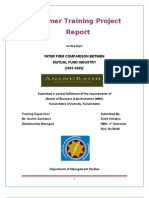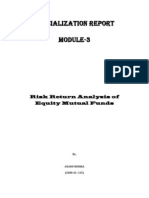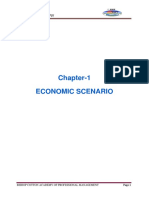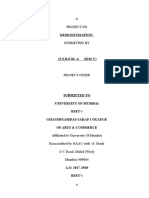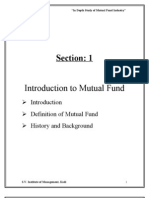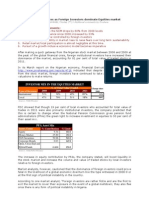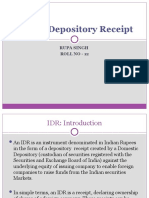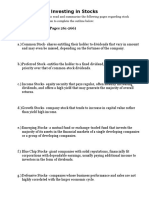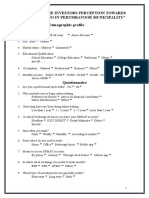An Empirical Study On Performance of Mutual Funds in India
An Empirical Study On Performance of Mutual Funds in India
Uploaded by
anon_336382763Copyright:
Available Formats
An Empirical Study On Performance of Mutual Funds in India
An Empirical Study On Performance of Mutual Funds in India
Uploaded by
anon_336382763Original Title
Copyright
Available Formats
Share this document
Did you find this document useful?
Is this content inappropriate?
Copyright:
Available Formats
An Empirical Study On Performance of Mutual Funds in India
An Empirical Study On Performance of Mutual Funds in India
Uploaded by
anon_336382763Copyright:
Available Formats
International Journal of Business and Management Tomorrow
Vol. 2 No. 6
An Empirical Study on Performance of Mutual Funds in India
Dr.S.Poornima, Associate Professor, PSGR Krishnammal College for Women, Coimbatore Theivanayaki M, Research Scholar, PSGR Krishnammal College for Women, Coimbatore
Abstract
Stock market plays a very vital role in developing economy in India. It is also attracting the rural people in recent years. Investors usually perceive that all capital market investment avenues are risky. Based on objectives and risk bearing capacities, investors go for different investment alternatives. Among the various investment possibilities, mutual fund seems to be viable for all kind of investors as it is considered to be a safer mode of investment. This study is an attempt to understand the performance of share market and to analyze the correlation of performance of mutual funds with market indices like Sensex and Nifty. As a part of this study, data is collected regarding performance of mutual funds and stock market for the last year 2007-08, 2008-09, 2009-10, 2009-10, and 2010-11, 20011-12. Top five mutual (growth) and ten index funds are taken as sampling. Thus it is analyzed by using statistical tools such as arithmetic Mean, Standard Deviation, Correlation and Testing Hypotheses. The study shows that, investors have made quite good returns in mutual funds like Reliance Vision Fund, HDFC Top 200 Fund etc. Keywords: Capital Market, Market Indices, Growth Funds
1. Introduction
Many of the investors across the world become billionaire within a short span of time by investing in share market, at the same time some investors lost amount in the same market also. In the year 1992, 2001 and 2008 report reveals, few investors lost their wealth and some of them committed suicide because of share market scandals. The famous investor Mr. Warren Buffet became the richest person because of his wise investment strategies; however it is not an alternative way to make money as it has huge amount of risk. An investor has ISSN: 2249-9962 June|2012 www.ijbmt.com Page | 1
International Journal of Business and Management Tomorrow
Vol. 2 No. 6
various investment options like debentures, shares, bank deposits, real estates etc. but choice of option is very essential. Mutual funds give higher returns because of professional management of fund. When we look at the risk and return pattern of investment, mutual funds have yielded good return over the past years compared to direct capital market. The investment in stock market is increasing at a faster rate in the recent years because of FIIs, FDIs, Stock market awareness etc. investment in Debentures, Bank Deposits, are not so attractive because of less amount of interest, as in real terms the value of money decreases over a period of time. The other option is to invest money in stock market, but a common man is not much aware of market and he is not much component enough to understand the functions of stock market and also it is an expansive proposal. The question to be answered is: what investment alternative should a small investor adopt? So obviously, mutual funds come to rescue. A mutual fund is a very simple concept which is combination of savings of investors. Mutual funds are highly cost efficient and very easy to invest in. considering the state of mind of the general investor, the research figures out to know how mutual fund is better than stock market, identify the most popular mutual fund among individual investors and analyze how far the mutual fund schemes are able to win the confidence of the investors.
1.1 Hypothesis
Investment in mutual fund yields higher return than direct capital market. There is a direct correlation between NAV of mutual fund and market indices- Sensex and Nifty.
1.2 Objectives
To understand the correlation between the performance of mutual fund and share market. To study the return on investment in share market. To understand the fund sponsor qualities influencing the selection on MFs schemes. To know how far the mutual fund schemes are able to win the confidence of the investors.
2. Research Methodology
For this study purpose data is collected through index funds, growth funds, and Market Indices-Sensex and Nifty. Five Top performing growth funds and ten index funds are selected for the financial year 2007-08, 200809, 2009-10, 2009-10, and 2010-11, 2011-12. The period stated above is particularly significant because of the economic cycles like boom, recession and recovery in respective years. The various tools, like arithmetic mean, correlation, standard deviation, are used to analyze the data. Following are the mutual fund schemes used for analysis in the study HDFC Top 200 Fund- Growth Option. Reliance Vision Fund- Growth Plan- Growth Option Franklin India Prima Fund- Growth Birla Sun Life Tax Plan Growth Option. UTI-G-Sec Fund- Growth.
3. Review of Literature
Dr.K.Ravichandran in his Research article titled A study on Investors preference towards various Derivatives market, published in the Journal of Contemporary Research in Management a Quarterly Journal, Vol3, September 2008. The objective of the study was to know the various investment avenues and the investors risk preference towards it and to find out the preference level of investors on various capital market instruments. The research article found few things like; 445 of investors are between age group of 31-40, and they are influenced by their friend and relatives. It is concluded with the point that, though the stock market is subjected to high risk, by using derivatives the loss can be minimized to an extent. Rajeswari Krishnan in her research article titled, Stock Market Investments in 2009- Can the Threats be Transformed into Opportunities? published in ICFAI Publications PORTFOLOI ORGANISER Of February, 2009 magazine opined as; the year 2008 was painful to the investors as stock markets collapsed across the globe. She concluded with, a stock market crash world-wide is considered to be an after effect of the global financial crises. The investors should reframe his strategies keeping in mind his long term goals rather than short term benefits and attaches more importance to fundamentals to make his investment decisions.
ISSN: 2249-9962
June|2012
www.ijbmt.com
Page | 2
International Journal of Business and Management Tomorrow
Vol. 2 No. 6
4. Analysis
4.1 Why should one choose to invest in a mutual fund?
Mutual funds are considered to be safer mode of investment; these are investment companies that pool money from investors at large and offer to sell and buy back its shares/ units on a continuous basis and thus rose to invest in various securities in different companies. If you are considering investment in stock market and are scared of unpredictable market volatility, you can definitely consider investing in mutual funds because of professional management. Some of the reasons that go strongly in favor of mutual funds are like it lowers risk factors. For the retail investor who doesnt have time the time and experience to analyze and invest in stocks and bonds, mutual funds offer a feasible investment alternative. This is because: Normally investment in mutual fund is financially viable for all the investors, as it provides the benefit of economical access to expensive stocks. Mutual Funds diversify the risk by investing in a basket of assets. An expert team of specialized fund managers managing the fund, each scheme has a separate professional fund manager. As mutual fund is an institutional investor, which may have enough bargaining power in markets, and has access to decisive corporate information which individual investor dont access.
4.2 Is Investment in Mutual Fund Risk Free?
Usually the risk depends on Fund Manager and Asset Allocation. Mutual Fund investments are not totally riskfree. In fact, investing in mutual funds contains the same risk as investing in the markets, the only difference being that is due to professional management of funds the controllable risks are substantially reduced.
4.3 Mutual Funds Vs other Investments
Investment in Mutual Fund is always safe because of its unique advantages with it. When an investor invests in bank deposits, debt market, usually risk will be very less but return is around 10%, whereas investment in share market, Forex market carries higher amount of risk having higher return. But mutual fund will give usually moderate return with moderate risk. Probability of loosing amount in mutual fund will be less as the risk is diversified with investment in different securities and fund is managed by professional experts. Exhibit-1 shows the comparative returns of mutual fund with other investment alternatives.
4.4 Mutual funds investments and the Sensex
There are plenty of schemes available in the market like equity fund, income fund and liquid fund. In each of these categories we have infrastructure fund, tax savings fund, bond fund, fixed term plan and many more. One of the important funds is Growth fund where the asset allocation of this fund is made in equity shares listed in stock market and index fund will be invested in share if indices. The correlation of these two funds should be obviously positive as direction moves towards the same way. Exhibit-2 and Exhibit-3 explain the return given by mutual fund companies and the percentage change in the same period of the indices. Investment of mutual fund in growth option indicates that, majority of allocation of fund will be invested in equity shares of various companies, so apparently there will be correlation between market indices and NAV of Growth funds. In order to know the correlation between the NAV and market indices, here top growth funds are selected and compared with BSEs Sensex and NSEs Nifty with NAV. So the comparison indicates, correlation is almost positive and very close to 1 (one) in majority of the cases.
4.5 Equity Index Fund
Equity Index Fund is the fund where the investment is made in equity market index like Sensex and Nifty. This is one of the most important schemes of the mutual fund which gives generally higher return as shown in the Exhibit-4 Value may differ from scheme to scheme due to differential NAV reporting period For the purpose of study, 10 index funds are taken from different AMCs and compared with their benchmark indexes. HDFC Index Sensex Plus Plan and ICICI Prudential Index Nifty Plan have given 37.88% and 26.73% respectively which shows the efficiency of the fund for the last five years. LICMF Index Fund Sensex Advantage Plan and HDFC Index Sensex Plan have given negative returns for the same. The correlation of mutual fund with NAVs it is almost nearer to 1, but in terms of returns mutual funds have given higher returns. So it seems that, investment in mutual fund is quite sensible than direct capital market, not only because of return but also for risk diversification, professional management and other benefits. ISSN: 2249-9962 June|2012 www.ijbmt.com Page | 3
International Journal of Business and Management Tomorrow
Vol. 2 No. 6
When we compare the investment in mutual fund and stock market, generally risk and return will be kept in mind. Investment in stock market has enormous risk and expected return is also more. However, the mutual fund overcomes the negative aspects of stock market like risk and uncertainty of return. Market over performed in some cases and in other cases mutual fund performance is quite more than market performance. So overall conclusion can be drawn based as on the above exhibits and diagram, investment in mutual fund is quite good compared to direct capital market as it gives higher return at moderate risk.
4.6 Findings
The study shows the performance of top five growth funds and 10 index funds along with their correlation with Sensex and Nifty, thus correlation is almost perfect positive in many of the cases, but the percentage change in the schemes for years is different with market indices. This is happened because of fund allocation with different sources. So it shows clearly that, mutual funds are performing better than stock market. It is observed from exhibit 6 that, mutual funds have yielded higher returns and grown at faster rate than market indices. ICICI Prudential Discovery, Tax Plan, Principal Funds have given around 150% return/change whereas market indices or benchmark has not been changed at the same rate. Reliance Vision, HDFC Top-200 and most of the growth funds have given around 100% return. So it shows clearly that, investment in mutual fund is quite better.
5. Conclusion
Mutual fund towers over the other investment alternatives. Investors usually get confusion while investing as he has plenty of opportunities like stock market, mutual fund, provident fund, real estates, etc. the mutual fund is proved to be a safer mode of investment and has been giving good returns compared to other investments and it is highly cost efficient and very easy to invest in, however it has got same kind of risk like direct capital market. Therefore investors have to think and choose the best alternative of investment. In case of mutual funds, the scheme which matches the need and objective of investors is very much essential to think. Longer the term of investment in mutual fund will give higher the return.
Dr.S.Poornima, Associate Professor, PSGR Krishnammal College for Women, Coimbatore
Theivanayaki M, Research Scholar, PSGR Krishnammal College for Women, Coimbatore
References
Mr. Sandeep Srivatsv of Ernst and Young, Dubai-Derivative Trading in Indian Stock Market; Brokers perception published in IIMB Management Review Journal for September 2009 Is investment- Uncertainty Relationship Monotonic? By Amaresh Das, Indian Journal of Finance, Volume IV http://www.amfiindia.com/spages/ http://www.finance.indidmart.com/india http://www.mutualfundsnavindia.com/getfundsmajor.php?key
Exhibits Exhibit-1- Comparative Returns Bank Deposits Debt Markets Share Markets Mutual fund 8%-10% 8%-125 0%->100%* 105-5-5 Rate varies as per the term Depending on securities Depends on Market Subject to Market Risk Source: calculated values compiled from the market observation *return on investment in share market and mutual fund varies beyond the 5 mentioned and subject to market risk. Exhibit-2: Correlation with Nifty Year HDFC Franklin UTI Birla 2007-2008 0.92 0.97 0.81 0.98 2008-2009 0.99 0.99 -0.96 0.99 2009-2010 0.90 0.82 0.75 0.62 2010-2011 0.92 0.90 0.79 0.74 2011-2012 0.95 0.94 0.84 0.96 Source: Calculated values compiled from AMFI and Nifty
Reliance 0.99 0.99 0.91 0.94 0.94
ISSN: 2249-9962
June|2012
www.ijbmt.com
Page | 4
International Journal of Business and Management Tomorrow
Year 2007-2008 2008-2009 2009-2010 2010-2011 2011-2012 Source: Calculated values complied from AMFI Exhibit-3: Correlation with Sensex HDFC Franklin UTI Birla 0.99 0.98 0.80 0.98 0.99 0.99 -0.96 0.99 0.98 0.83 0.71 0.99 0.97 0.87 0.85 0.98 0.99 0.95 0.82 0.99 Reliance 0.99 0.99 0.99 0.99 0.98
Vol. 2 No. 6
Exhibit-4: Comparison on Index funds with Market Indices AMC Scheme Returns 1 HDFC Index Sensex Plus Plan HDFC Mutual Fund 10.81 ICICI Prudential Mutual 2 ICICI Prudential Index-Nifty Plan 9.15 Fund ICICI Prudential Mutual 3 ICICI Prudential Index Plan 9.15 Fund ICICI Prudential Mutual 4 ICICI Prudential Spice Fund(S) 7.57 Fund 5 Birla Sun Life Index Fund Birla Sun Life Mutual Fund 7.92 ICICI Prudential Mutual 6 ICICI Prudential Spice Fund(N) 7.57 Fund 7 ING Vysya Nifty Plus Fund ING Vysya Mutual Fund 7.06 8 SBI Magnum Index Fund SBI Mutual Fund 5.61 9 HDFC Index Sensex Plan HDFC Mutual Fund 3.81 LICMF Index Fund-Sensex Advantage 10 LICMF Mutual Fund 2.26 Plan Source: http://www.myris.com//mutual/topgainers/index.php *Percentage change in schemes over market indices ** Return of schemes for period corresponding No Scheme
Index Returns** 7.84 7.22 7.84 7.22 7.84 7.84 7.84 7.84 7.84 7.84
Difference in %* 37.88265 26.7313 16.70918 4.847654 1.020408 -3.44388 -9.94898 -28.4439 -51.4031 -71.1735
Exhibit-6: Performance of Funds as on 01.04.2012 Equity Diversified Growth Funds CRISIL Rank AUM (Rs. Cr) Returns(%) as on May 18, 2012 I year II Year III Year V Year Quantum Long-Term Equity 1 105.66 -4.5 4.0 18.2 9.9 Reliance Equity Opportunity 1 3325.34 0.4 6.5 23.6 9.4 HDFC Growth fund 2 1261.95 -6.6 2.9 13.7 9.0 UTI Dividend Yield Fund 2 3599.88 -8.3 1.8 14.2 10.7 ICICI Pru-Dynamic Plan 2 4092.27 -5.7 3.4 15.5 7.4 HDFC Equity Fund 2 9916.37 -12.2 0.8 15.0 8.9 Reliance Growth Fund 3 5769.98 -8.9 -3.6 10.3 6.7 SBI Magnum Contra Fund 4 2702.94 -9.7 -1.8 8.4 3.9 Source: http://www.moneycontrol.com/mutual-funds/performance-tracker/returns/diversified-equity-3.html Figure-1: Comparative Returns of Index and NAVs 12 10 8 6 4 2 0
Scheme Returns Index Returns**
ISSN: 2249-9962
June|2012
www.ijbmt.com
Page | 5
You might also like
- Advanced Price Action Analysis PDFDocument62 pagesAdvanced Price Action Analysis PDFFernandoFierroGonzalez75% (8)
- Reading 37 - Case Study in Portfolio Management InstitutionalDocument2 pagesReading 37 - Case Study in Portfolio Management InstitutionalHieu NgNo ratings yet
- Activity I Problem 15-6: W/ ChangesDocument106 pagesActivity I Problem 15-6: W/ Changesmore100% (1)
- Chapter Buying and Selling SecuritiesDocument11 pagesChapter Buying and Selling SecuritiesMd. Jahangir AlamNo ratings yet
- Chapter 12 Production and GrowthDocument38 pagesChapter 12 Production and GrowthNguyên NgôNo ratings yet
- Session - 3 and Session 4 Business AnalyticsDocument60 pagesSession - 3 and Session 4 Business AnalyticsBandita ParidaNo ratings yet
- An Introduction To Equity ValuationDocument37 pagesAn Introduction To Equity ValuationAamir Hamza MehediNo ratings yet
- Course Syllabus - GMU Spring 2018 - BUS 310 - Section 15 - Business Analytics IIDocument7 pagesCourse Syllabus - GMU Spring 2018 - BUS 310 - Section 15 - Business Analytics IIAnonymous OYqRcuae100% (1)
- MMS Demand ForecastingDocument18 pagesMMS Demand ForecastingMilan PateliyaNo ratings yet
- Experimental and Panel Data: Slides by Niels-Hugo Blunch Washington and Lee UniversityDocument18 pagesExperimental and Panel Data: Slides by Niels-Hugo Blunch Washington and Lee UniversityCarine TeeNo ratings yet
- Mankiw (1995) - The Growth of NationsDocument53 pagesMankiw (1995) - The Growth of NationsAnonymous WFjMFHQ100% (1)
- Analysis of Financial Statements - FinalDocument25 pagesAnalysis of Financial Statements - FinalAnonymous y3E7iaNo ratings yet
- Introduction To Econometrics - Stock & Watson - CH 10 SlidesDocument99 pagesIntroduction To Econometrics - Stock & Watson - CH 10 SlidesAntonio AlvinoNo ratings yet
- Mutual Funds: Mutual Funds Definition Refers To The Meaning of Mutual Fund, Which Is A FundDocument23 pagesMutual Funds: Mutual Funds Definition Refers To The Meaning of Mutual Fund, Which Is A FundKamal YadavNo ratings yet
- Behavioral Corporate FinanceDocument14 pagesBehavioral Corporate Financejanak0609No ratings yet
- 3 INVESTORS' PERCEPTION TOWARDS VARIOUS INVESTMENT AVENUES Aug 7447P 1 PDFDocument10 pages3 INVESTORS' PERCEPTION TOWARDS VARIOUS INVESTMENT AVENUES Aug 7447P 1 PDFsuman v bhatNo ratings yet
- Factors Affecting Divident Policy DeciDocument26 pagesFactors Affecting Divident Policy DeciVj AutiNo ratings yet
- A Study On Customer Perception Towards Post Office Saving SchemesDocument61 pagesA Study On Customer Perception Towards Post Office Saving Schemesirshad irshuNo ratings yet
- Objective of Study Concepts Investment Options Data Collection Analysis Recommendation Limitations ReferencesDocument26 pagesObjective of Study Concepts Investment Options Data Collection Analysis Recommendation Limitations Referenceshtikyani_1No ratings yet
- Small Savings SchemesDocument16 pagesSmall Savings SchemesPranav BhattadNo ratings yet
- Chapter 1 Introduction: Risk & ReturnDocument32 pagesChapter 1 Introduction: Risk & ReturnMaridasrajanNo ratings yet
- IPODocument4 pagesIPORameezNo ratings yet
- Dividend Discount Model in Valuation of Common StockDocument15 pagesDividend Discount Model in Valuation of Common Stockcaptain_bkx0% (1)
- A Project Report OnDocument54 pagesA Project Report Onnitinjadhav30No ratings yet
- Markowitz TheoryDocument4 pagesMarkowitz TheoryshahrukhziaNo ratings yet
- Income Tax Saving SchemesDocument14 pagesIncome Tax Saving Schemesanindya_kunduNo ratings yet
- A Study On Mutual Funds at Reliance Mutual FundsDocument82 pagesA Study On Mutual Funds at Reliance Mutual FundsRajesh BathulaNo ratings yet
- Managerial Economics and Financial Analysis: TopicDocument12 pagesManagerial Economics and Financial Analysis: TopicJeswaanth GogulaNo ratings yet
- Economic AnalysisDocument83 pagesEconomic AnalysisAhmed Sayed0% (1)
- Short Notes 23-34Document74 pagesShort Notes 23-34Syed Abdul Mussaver ShahNo ratings yet
- Project AnkitDocument78 pagesProject AnkitAnkit Chhabra100% (1)
- Literature ReviewDocument35 pagesLiterature ReviewSanjida100% (1)
- 11 - Chapter 2 PDFDocument42 pages11 - Chapter 2 PDFvipul patilNo ratings yet
- Stock and Watson - Slides For Chapter 4Document43 pagesStock and Watson - Slides For Chapter 4Bruno CapuzziNo ratings yet
- Portfolio Analysis: By: Sareeta Yadav Roll No. 16 M. Com (FINANCE) 3 SEMDocument13 pagesPortfolio Analysis: By: Sareeta Yadav Roll No. 16 M. Com (FINANCE) 3 SEMsarita yadavNo ratings yet
- The Capital Asset Pricing ModelDocument43 pagesThe Capital Asset Pricing ModelTajendra ChughNo ratings yet
- Toaz - Info A Study On Whether Taxation Is A Selling Tool For Life Insurance PR - 5 70 2 66Document65 pagesToaz - Info A Study On Whether Taxation Is A Selling Tool For Life Insurance PR - 5 70 2 66Dance on floor100% (1)
- IntroductionDocument127 pagesIntroductionShiva KonarNo ratings yet
- Product PositioningDocument8 pagesProduct PositioningCheryl Musser HaganNo ratings yet
- Risk Return Analysis of Mutual FundsDocument23 pagesRisk Return Analysis of Mutual FundsAnand Mishra100% (1)
- Project KMFDocument96 pagesProject KMFLabeem SamanthNo ratings yet
- An Overview of Financial Statement AnalysisDocument37 pagesAn Overview of Financial Statement AnalysisShynara MuzapbarovaNo ratings yet
- 10 Stockwatson 1Document65 pages10 Stockwatson 1Imran AkberNo ratings yet
- A Framework For Financial Statement AnalysisDocument72 pagesA Framework For Financial Statement AnalysisSaif KhanNo ratings yet
- Master's Degrees in Analytics and Data ScienceDocument3 pagesMaster's Degrees in Analytics and Data ScienceJai SebastianNo ratings yet
- Revenue Management - Gesualdo MartialDocument6 pagesRevenue Management - Gesualdo MartialGesualdo Martial LunaNo ratings yet
- Investment Analysis and Portfolio Management: Frank K. Reilly & Keith C. BrownDocument78 pagesInvestment Analysis and Portfolio Management: Frank K. Reilly & Keith C. BrownNoreenakhtar100% (1)
- Portfolio Analysis Banking SectorDocument40 pagesPortfolio Analysis Banking SectorMaster RajharshNo ratings yet
- Chapter 24-Multivariate Statistical Analysis: True/FalseDocument13 pagesChapter 24-Multivariate Statistical Analysis: True/FalseYaroslav BondarenkoNo ratings yet
- Housing Finance: (Home Loan Schemes)Document41 pagesHousing Finance: (Home Loan Schemes)Shriram LeleNo ratings yet
- Traditional Credit AnalysisDocument1 pageTraditional Credit AnalysisAnkita DasNo ratings yet
- Role of Credit Rating AgenciesDocument6 pagesRole of Credit Rating AgenciesDharam TomerNo ratings yet
- A Study On Consumer Perception Towards P PDFDocument80 pagesA Study On Consumer Perception Towards P PDFNikunj GokuliaNo ratings yet
- Introduction To Econometrics - Stock & Watson - CH 6 SlidesDocument59 pagesIntroduction To Econometrics - Stock & Watson - CH 6 SlidesAntonio AlvinoNo ratings yet
- Surjit Singh Bhatia and Ors Vs Tej Raj Singh GoelDocument10 pagesSurjit Singh Bhatia and Ors Vs Tej Raj Singh GoelAbhineet KaliaNo ratings yet
- Determinants of Equity Share Prices in IndiaDocument10 pagesDeterminants of Equity Share Prices in IndiaMuhammad RezaNo ratings yet
- Demonetisation: A Project OnDocument52 pagesDemonetisation: A Project OnSwarnajeet GaekwadNo ratings yet
- The Perfect StormDocument3 pagesThe Perfect StormWolfSnapNo ratings yet
- Derivatives FreshDocument85 pagesDerivatives FreshSatyanarayana KobberaNo ratings yet
- Fame India LTD 2003Document17 pagesFame India LTD 2003Harish MordaniNo ratings yet
- Mutual FundDocument170 pagesMutual FundPatel UrveshNo ratings yet
- Chapter IDocument83 pagesChapter IAruna TalapatiNo ratings yet
- Sectoral Funds Outperformed Diversified FundsDocument21 pagesSectoral Funds Outperformed Diversified FundsMalathi KuttyNo ratings yet
- Retail Market Evaporates As Foreign Investors Dominate NSE - 150412Document2 pagesRetail Market Evaporates As Foreign Investors Dominate NSE - 150412ProshareNo ratings yet
- Algorithmic Trading High Frequency and L-60441353Document24 pagesAlgorithmic Trading High Frequency and L-60441353DALJEET SINGHNo ratings yet
- KALRAYDocument2 pagesKALRAYMuhammad ImranNo ratings yet
- Abdul Samad (01-112182-043)Document5 pagesAbdul Samad (01-112182-043)ABDUL SAMADNo ratings yet
- Foreign Portfolio Equity Investment in Egypt An Analytical OverviewDocument55 pagesForeign Portfolio Equity Investment in Egypt An Analytical OverviewGibran KasrinNo ratings yet
- Indian Depository Receipt1Document17 pagesIndian Depository Receipt1Rupa SinghNo ratings yet
- 5 Ways Post BTFD 2018Document17 pages5 Ways Post BTFD 2018emirav2No ratings yet
- Security Analysis and Portfolio ManagementDocument36 pagesSecurity Analysis and Portfolio Managementthe_randomistNo ratings yet
- Stocks and AstrologyDocument38 pagesStocks and AstrologyJyotishacharya100% (1)
- How Does The Stock Exchange Work?: © This Worksheet Is FromDocument3 pagesHow Does The Stock Exchange Work?: © This Worksheet Is FromFiorella Stefanne Collachagua GamionNo ratings yet
- A Project Report OnDocument20 pagesA Project Report OnRavi JaglanNo ratings yet
- Financial Markets Case StudyDocument7 pagesFinancial Markets Case StudyKrizel July MoncayNo ratings yet
- SEBI Final Project PDFDocument56 pagesSEBI Final Project PDFnidhi UnnikrishnanNo ratings yet
- A Study On Indicators of Investment Opportunities in Stock MarketDocument54 pagesA Study On Indicators of Investment Opportunities in Stock Marketshyam krishnaNo ratings yet
- TWG Basics of IsmDocument6 pagesTWG Basics of Ismoshristi13No ratings yet
- List of All Fees, Charges, and Taxes On Trading and Investing - ZerodhaDocument5 pagesList of All Fees, Charges, and Taxes On Trading and Investing - Zerodhashah siddiqNo ratings yet
- Vice Presidents/ V: Sr. No. Name of The Person TenureDocument7 pagesVice Presidents/ V: Sr. No. Name of The Person TenurePREET10No ratings yet
- Selam Login FilesDocument5 pagesSelam Login Filesv selvasuganya v selvasuganyaNo ratings yet
- Test Bank For Corporate Finance 2nd Canadian Edition BerkDocument14 pagesTest Bank For Corporate Finance 2nd Canadian Edition BerkCarlene Peterson100% (44)
- Karvy Stock Broking Ltd. Internship ReportDocument23 pagesKarvy Stock Broking Ltd. Internship ReportYashPalNo ratings yet
- Case 26 - Analysis GuidanceDocument2 pagesCase 26 - Analysis GuidanceVoramon PolkertNo ratings yet
- Chap 1 Overview of Financial Markets AnalysisDocument124 pagesChap 1 Overview of Financial Markets AnalysisYibeltal AssefaNo ratings yet
- Blue Chip Share in Bangladesh.. (Premier University)Document65 pagesBlue Chip Share in Bangladesh.. (Premier University)সুদেষ্ণা দাশ0% (2)
- Investing in Stocks WorksheetDocument5 pagesInvesting in Stocks Worksheetapi-311692437No ratings yet
- 0 - Summer Internship Project ReportDocument26 pages0 - Summer Internship Project ReportSandeep SharmaNo ratings yet
- Lucky Lanka IPO - Capital TRUST Research 275Document5 pagesLucky Lanka IPO - Capital TRUST Research 275Randora LkNo ratings yet
- Questionnaire NW OrgDocument3 pagesQuestionnaire NW OrgEldhose JoseNo ratings yet





